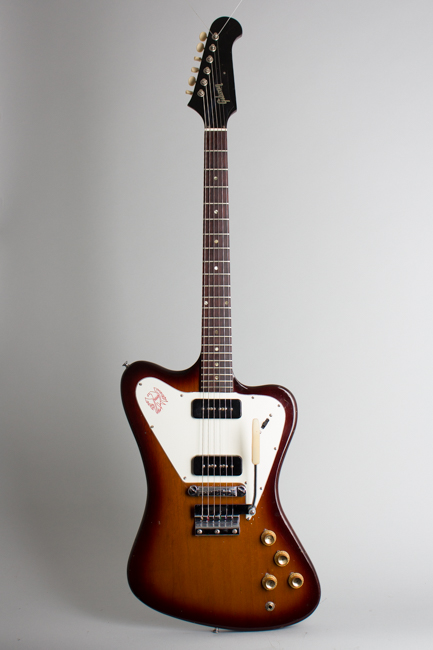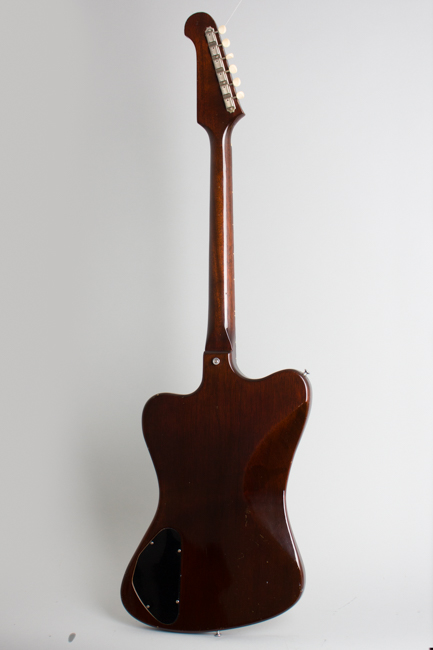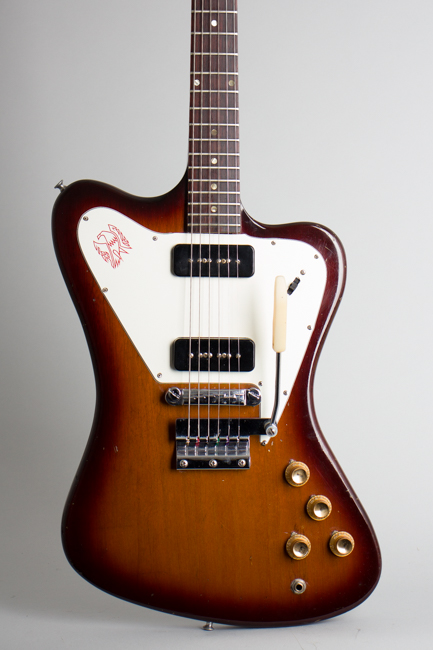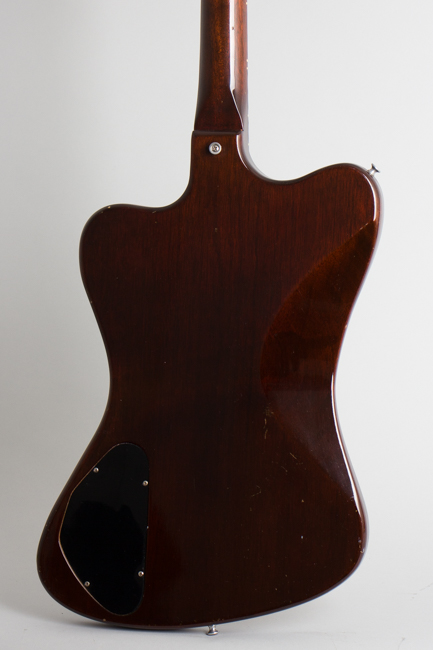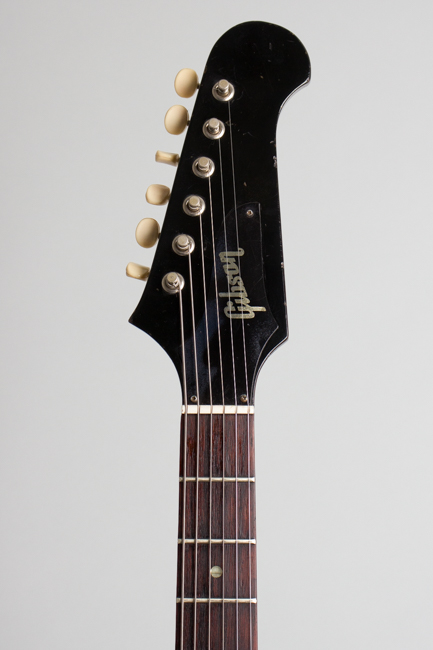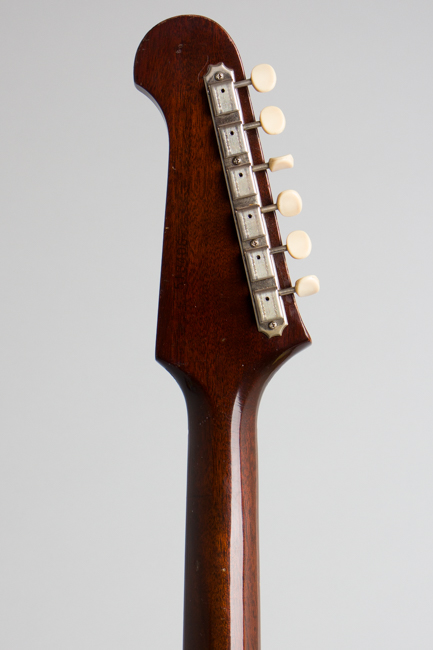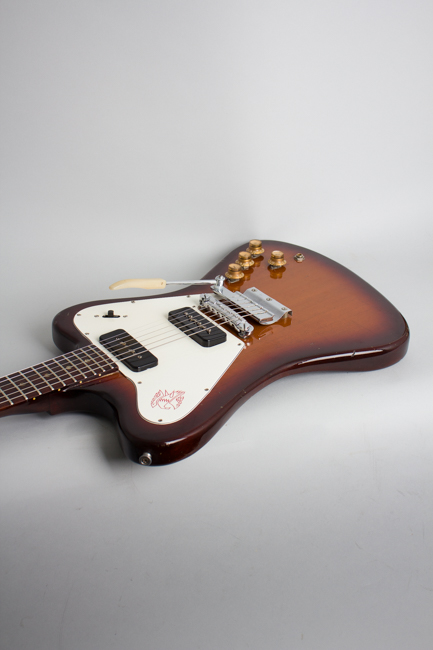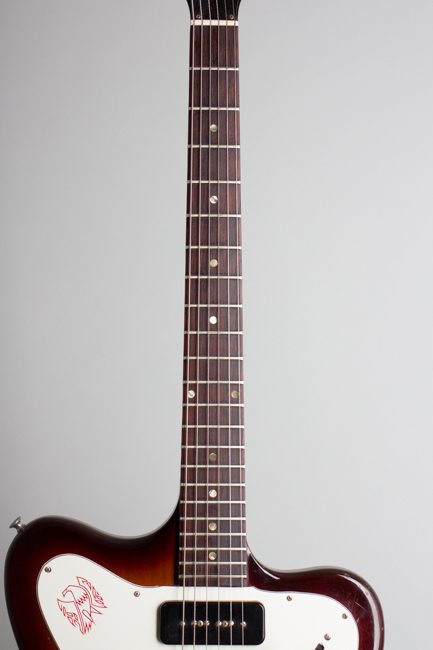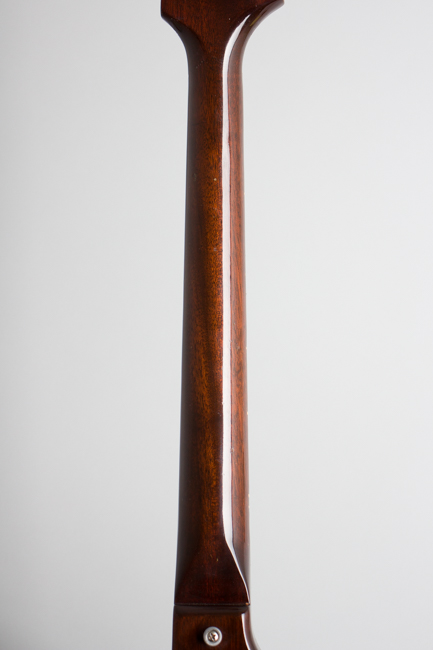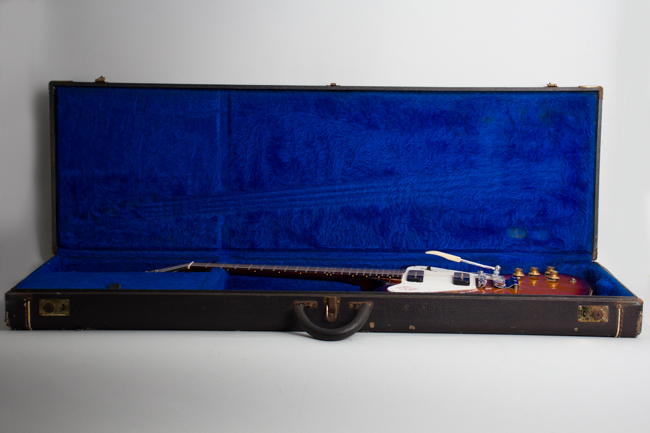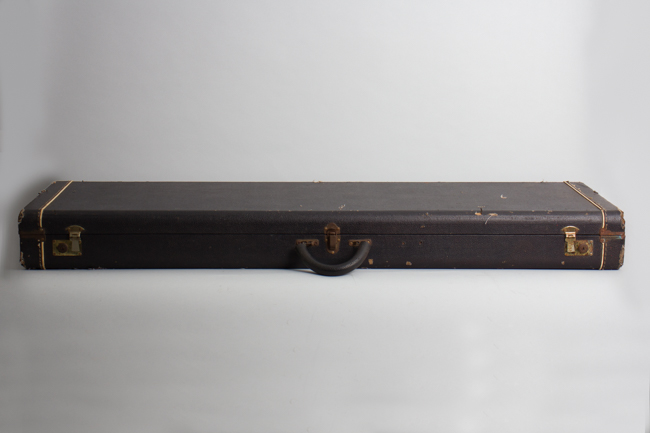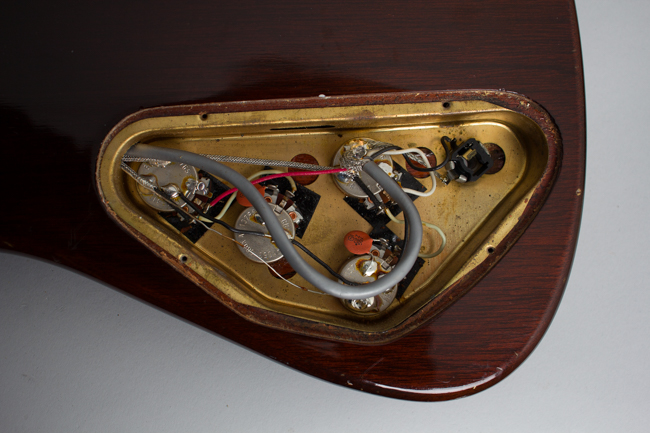Gibson Firebird I Solid Body Electric Guitar (1965)
This item has been sold.
Item # 11261
Prices subject to change without notice.
Gibson Firebird I Model Solid Body Electric Guitar (1965), made in Kalamazoo, Michigan, serial # 513406, sunburst lacquer finish, mahogany body and neck, rosewood fingerboard, black hard shell case.
For a long time one of Gibson's less heralded 1960s classics, the second-try "non-reverse" Firebird models were lower-priced, simplified versions of the earlier "reverse" body Firebird series guitars. Introduced in at the summer NAMM show in 1965, the new Firebirds were available through the late 1960s in dwindling quantities, but never really caught on with pro players at the time.
This example of the basic model Firebird I is finished in the standard sunburst, by far the most common livery. Gibson lore holds that most dealers simply ignored the special Firebird color chart brochure Gibson helpfully provided, as they were more interested in selling stock models off the wall. "If you've got a red one, they want a blue one" was the complaint, and whatever the truth, the solid color guitars are exponentially rarer than the standard sunburst models.
This Firebird I has a body of fluidly sculpted Honduras mahogany with a one-piece glued-in neck, far simpler to build than the original laminate neck-through-body Firebird design. The rosewood fingerboard is unbound and dot inlaid, the same for all models. The non-reverse I is distinguished by offering two plastic-covered P-90 pickups instead of the mini-humbuckers used on the earlier models.
Typically for late 1965 this 'bird has chrome plated hardware, including Gibson's "short" Vibrola unit with a plastic-tipped handle and the stud-mounted solid bridge. These Firebirds were fitted with a fairly cheap slider switch for pickup selection that often broke; this one has replaced with a direct replacement older piece. The tuners are plastic-button Kluson Deluxe in a single 6-unit strip.
The visible pot codes date to the 3-something week of 1965 (all are at least partially soldered over) the serial number 513XXX is a series used repeatedly by Gibson in the 1960s but the features on the instrument suggest shipment in late 1965 or early 1966. The knobs are the older capped early '60s style pieces, usually replaced by "Witch Hat" style in 1966-7. The nut width is the 1965 and later 1 1/2" shared by all second generation Firebirds, narrower than earlier "reverse" Firebird necks but overall not as insubstantial-feeling as many super-skinny period SG necks.
This is a great-sounding guitar, with powerful P-90 pickups that really growl when cranked. While the "non-reverse" Firebirds often used to be discounted in Gibson history, they have found a growing cadre of enthusiasts in the 21st century, enough for Gibson to finally re-issue the model recently. They remain distinctive guitars unlike any other in look or feel and excellent players instruments. Extremely light, fast playing, and super stylish, this Firebird III is a fine example of an oft-underappreciated Gibson model, an unrepentant rocker's guitar.
Overall length is 43 3/8 in. (110.2 cm.), 13 7/16 in. (34.1 cm.) wide at lower bout, and 1 3/8 in. (3.5 cm.) in depth, measured at side of rim. Scale length is 24 3/4 in. (629 mm.). Width of nut is 1 1/2 in. (38 mm.).
This is a nicely well-preserved 'bird overall, nearly all original and showing some minor wear but none of the common damage these models often suffer. There have never been any headstock or control cavity cracks. The all-original finish shows typical checking and small dings, dents and chips in spots, mostly on the edges but still retains a shiny original patina. Overall the fairly dark sunburst on the face is well-preserved with no major fading and or yellowing. The headstock has some small edge chips.
All hardware is original except for the slider switch and some attendant wiring which has been neatly replaced (unsurprising as the flimsy originals often broke in use). The pickguard is freer than most of the shrinkage cracks by the screws; only the lower rear top has polled off, the bird emblem is really strong and intact. Many of these pickguards have shrunken up far worse than this one has! The truss rod cover has some odd patterning on the face; perhaps something was glued over it long ago.
The original frets show very minor wear and still have plenty of meat to them, and the neck angle is much better than many of these, allowing the vibrato to function properly. Overall a great looking, playing and sounding Firebird, in a slightly oversize 1970s bass case that is not a perfect fit but offers good protection. Overall Excellent - Condition.
For a long time one of Gibson's less heralded 1960s classics, the second-try "non-reverse" Firebird models were lower-priced, simplified versions of the earlier "reverse" body Firebird series guitars. Introduced in at the summer NAMM show in 1965, the new Firebirds were available through the late 1960s in dwindling quantities, but never really caught on with pro players at the time.
This example of the basic model Firebird I is finished in the standard sunburst, by far the most common livery. Gibson lore holds that most dealers simply ignored the special Firebird color chart brochure Gibson helpfully provided, as they were more interested in selling stock models off the wall. "If you've got a red one, they want a blue one" was the complaint, and whatever the truth, the solid color guitars are exponentially rarer than the standard sunburst models.
This Firebird I has a body of fluidly sculpted Honduras mahogany with a one-piece glued-in neck, far simpler to build than the original laminate neck-through-body Firebird design. The rosewood fingerboard is unbound and dot inlaid, the same for all models. The non-reverse I is distinguished by offering two plastic-covered P-90 pickups instead of the mini-humbuckers used on the earlier models.
Typically for late 1965 this 'bird has chrome plated hardware, including Gibson's "short" Vibrola unit with a plastic-tipped handle and the stud-mounted solid bridge. These Firebirds were fitted with a fairly cheap slider switch for pickup selection that often broke; this one has replaced with a direct replacement older piece. The tuners are plastic-button Kluson Deluxe in a single 6-unit strip.
The visible pot codes date to the 3-something week of 1965 (all are at least partially soldered over) the serial number 513XXX is a series used repeatedly by Gibson in the 1960s but the features on the instrument suggest shipment in late 1965 or early 1966. The knobs are the older capped early '60s style pieces, usually replaced by "Witch Hat" style in 1966-7. The nut width is the 1965 and later 1 1/2" shared by all second generation Firebirds, narrower than earlier "reverse" Firebird necks but overall not as insubstantial-feeling as many super-skinny period SG necks.
This is a great-sounding guitar, with powerful P-90 pickups that really growl when cranked. While the "non-reverse" Firebirds often used to be discounted in Gibson history, they have found a growing cadre of enthusiasts in the 21st century, enough for Gibson to finally re-issue the model recently. They remain distinctive guitars unlike any other in look or feel and excellent players instruments. Extremely light, fast playing, and super stylish, this Firebird III is a fine example of an oft-underappreciated Gibson model, an unrepentant rocker's guitar.
Overall length is 43 3/8 in. (110.2 cm.), 13 7/16 in. (34.1 cm.) wide at lower bout, and 1 3/8 in. (3.5 cm.) in depth, measured at side of rim. Scale length is 24 3/4 in. (629 mm.). Width of nut is 1 1/2 in. (38 mm.).
This is a nicely well-preserved 'bird overall, nearly all original and showing some minor wear but none of the common damage these models often suffer. There have never been any headstock or control cavity cracks. The all-original finish shows typical checking and small dings, dents and chips in spots, mostly on the edges but still retains a shiny original patina. Overall the fairly dark sunburst on the face is well-preserved with no major fading and or yellowing. The headstock has some small edge chips.
All hardware is original except for the slider switch and some attendant wiring which has been neatly replaced (unsurprising as the flimsy originals often broke in use). The pickguard is freer than most of the shrinkage cracks by the screws; only the lower rear top has polled off, the bird emblem is really strong and intact. Many of these pickguards have shrunken up far worse than this one has! The truss rod cover has some odd patterning on the face; perhaps something was glued over it long ago.
The original frets show very minor wear and still have plenty of meat to them, and the neck angle is much better than many of these, allowing the vibrato to function properly. Overall a great looking, playing and sounding Firebird, in a slightly oversize 1970s bass case that is not a perfect fit but offers good protection. Overall Excellent - Condition.
